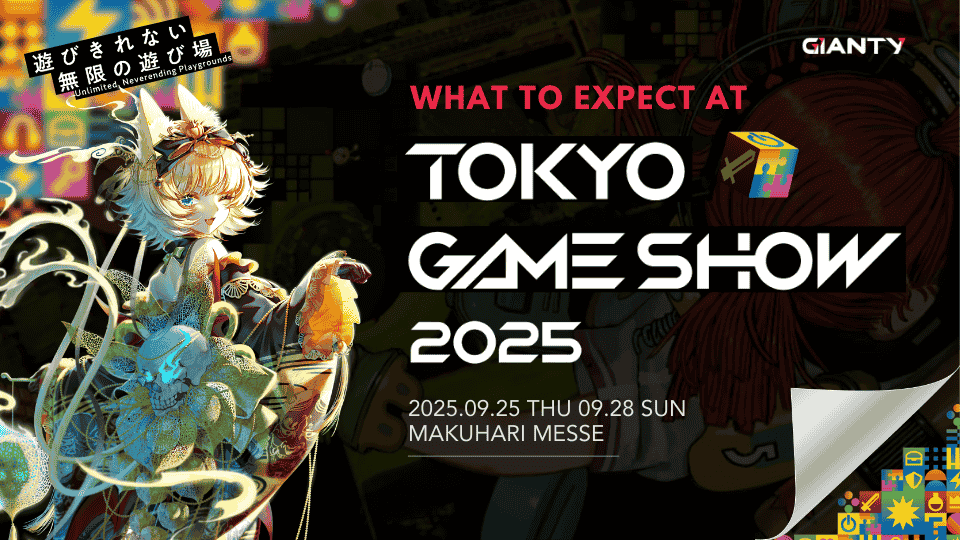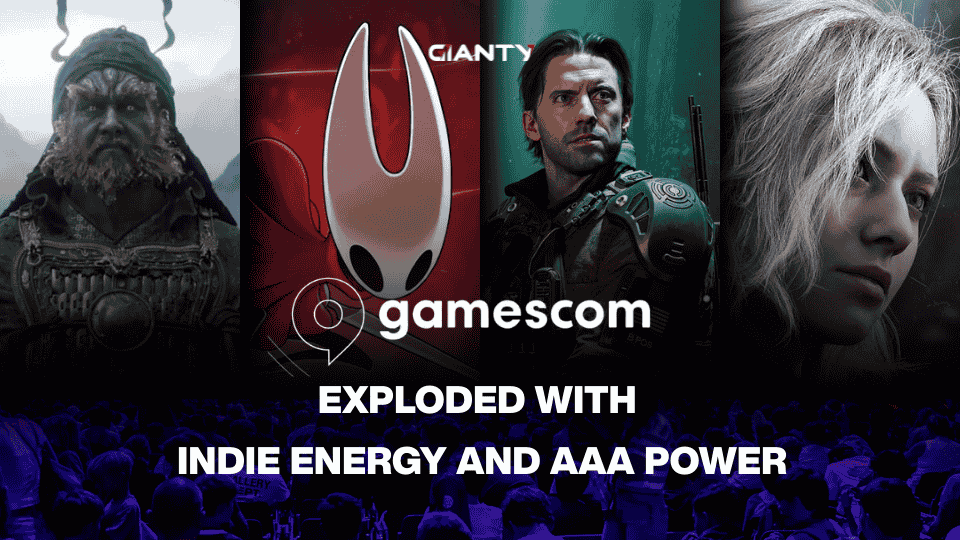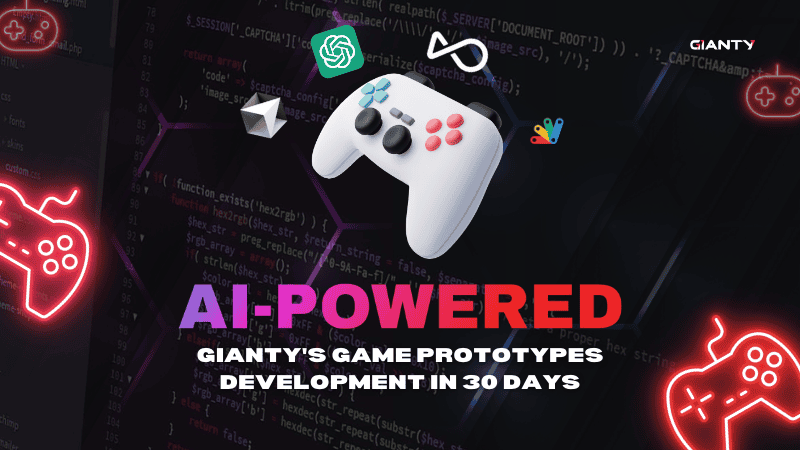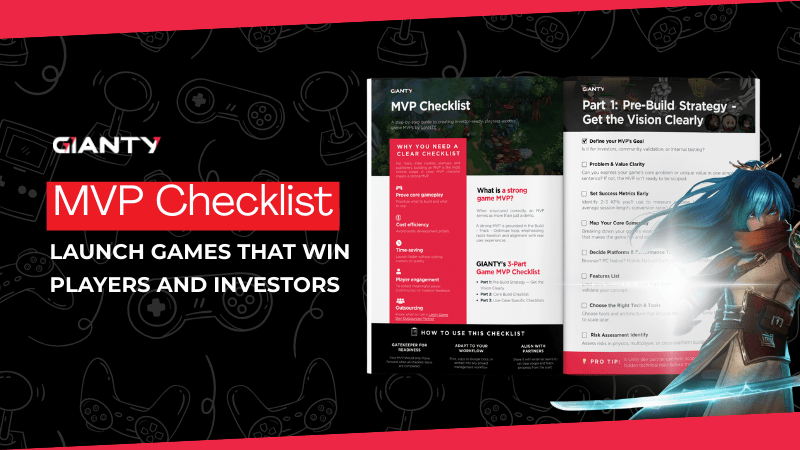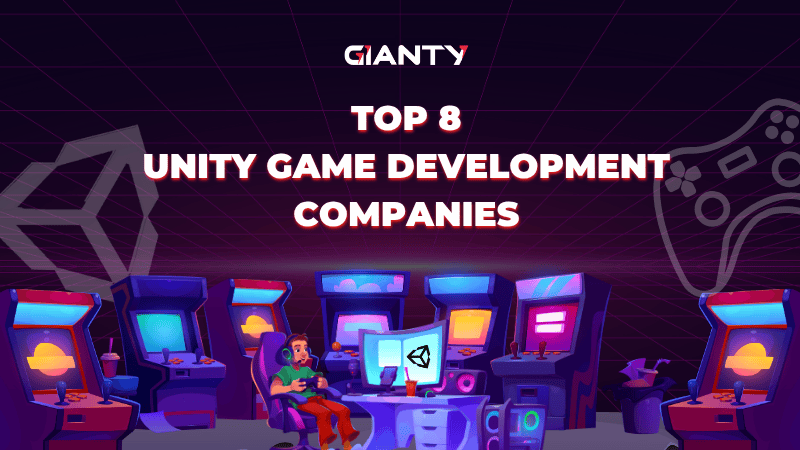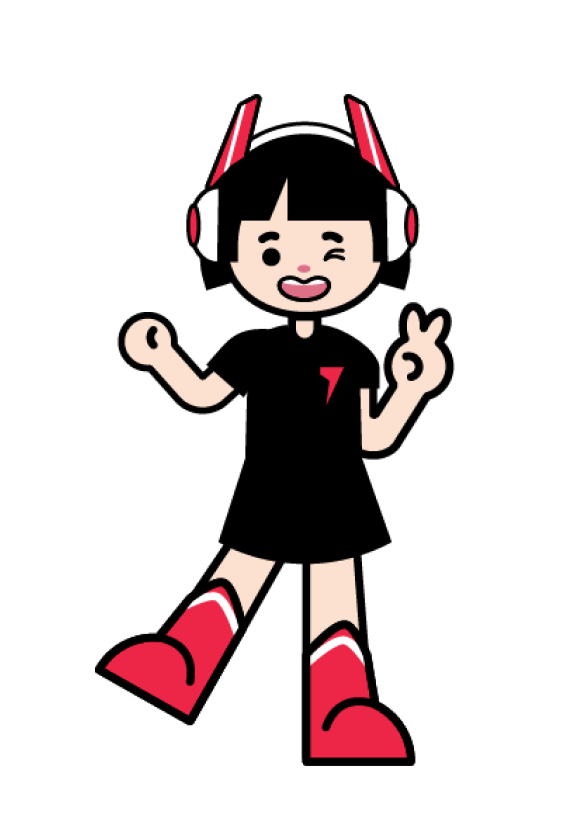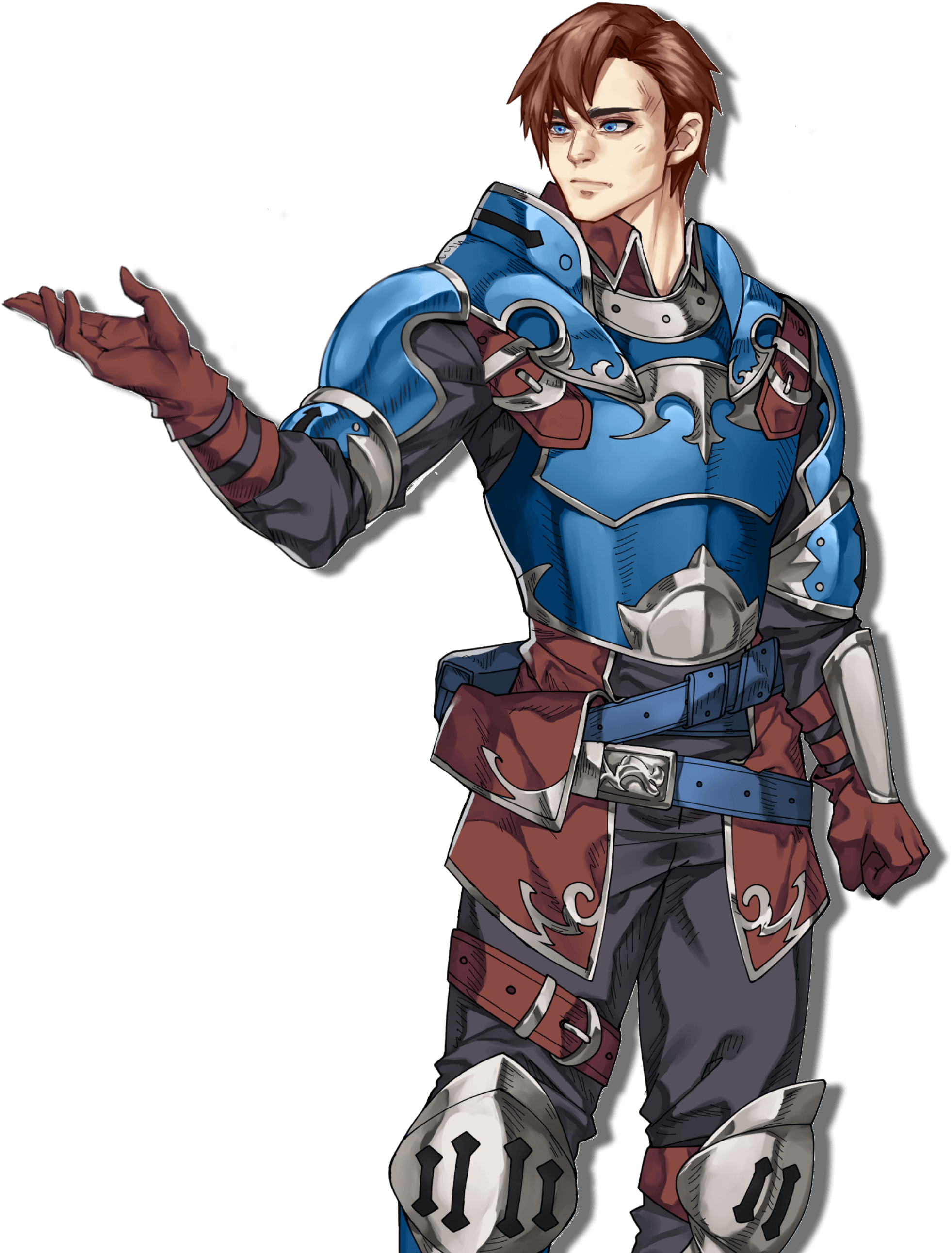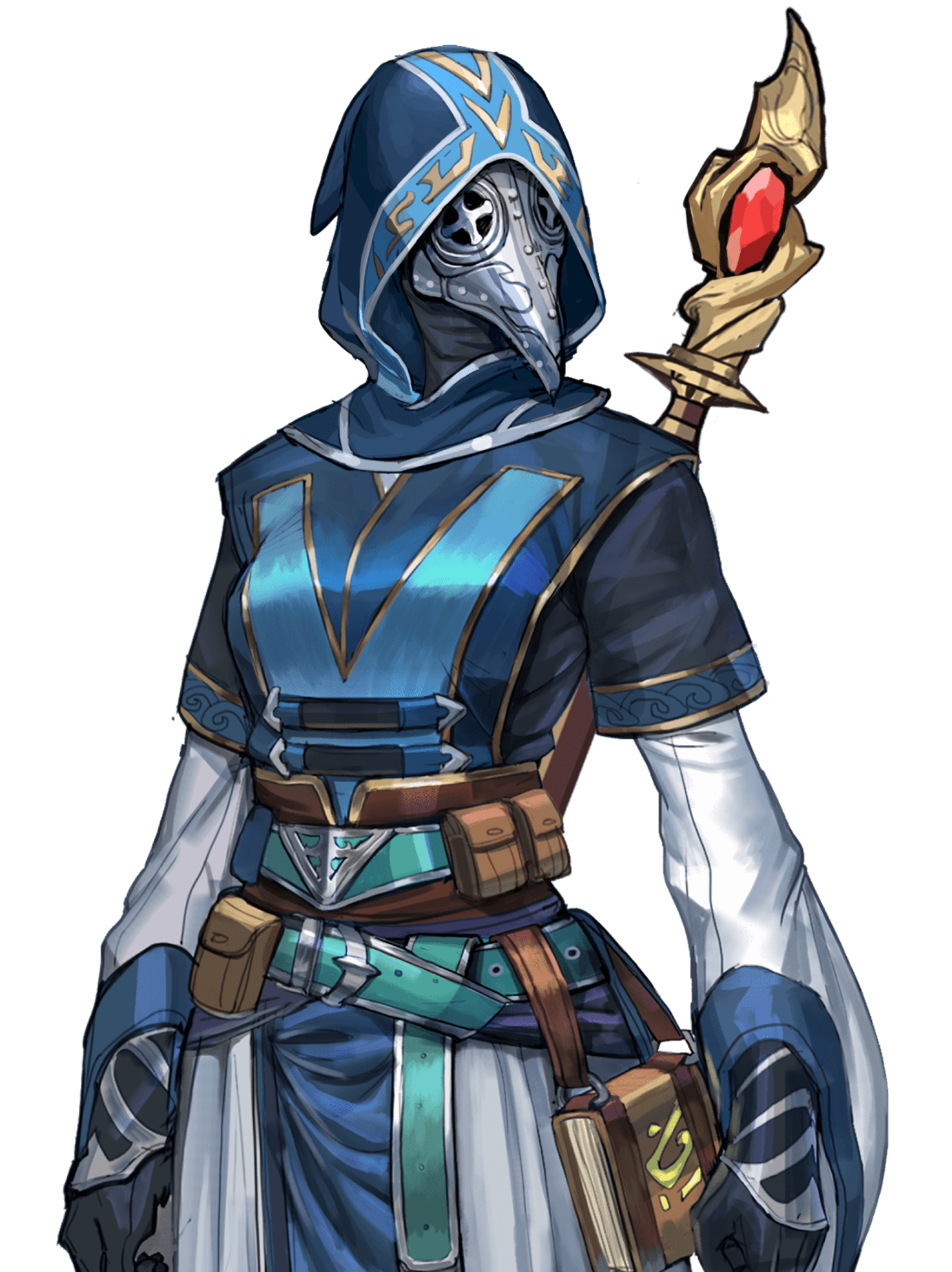If you’re planning a Unity game, the first big question is: “How much does Unity game development cost?”. The honest answer: it depends – mainly on what you build, how polished it needs to be, which platforms you target, and who builds it. Unity game development outsourcing is often the fastest way to lower total game development cost. A good partner reduces the biggest part of your game development cost estimation and trims the rest of the game development cost breakdown.
The tips below come from GIANTY’s 20+ years working with Unity across mobile, PC, and console. We’ve distilled these ranges and practices from hundreds of prototypes, MVPs, ports, and live-ops projects. Let’s explore those cost factors, give range-based estimates for an MVP, reveal common hidden costs, and show practical ways to stay on budget.
Factors that affect Unity Game Development Cost
Think of game costs like building a house. The price changes with the size, the materials, the features, and the location. Games are similar.
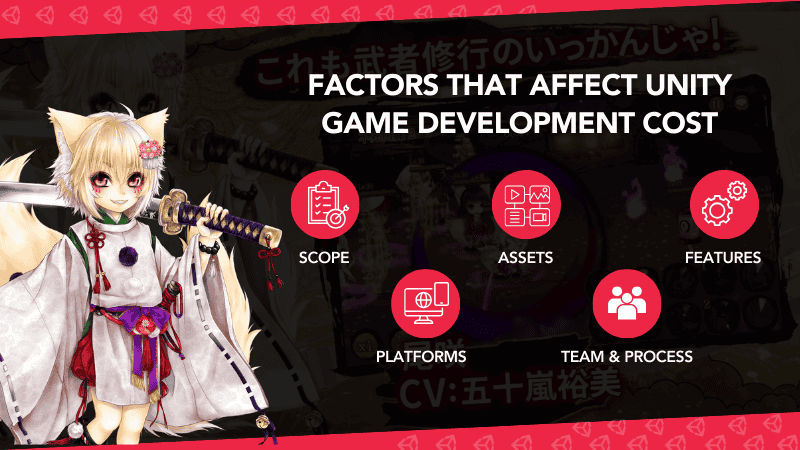
Scope: Show how big your game is
- Content: How many levels, enemies, bosses, items,…
- Polish: Do you need smooth animations, strong VFX, great UI/UX, and steady performance?
- Replay vs. breadth: A short game that’s fun to replay is usually cheaper than a huge game with lots of unique content.
Tips: Decide the core loop first (the main activity players repeat). Prove it’s fun. Add more content later. You can find the checklist “Tips for a strong MVP” to learn more.
Assets (art, models, UI, and audio)
- Custom-made game art assets look unique but take more time and budget.
- Asset store / ready-made assets are faster and cheaper, but need cleanup so everything matches.
- Audio: For MVPs, many teams use licensed sounds/music or AI-generated music; custom music comes later.
Tip: Mix store assets with a few custom “hero” pieces (main character, boss, key UI). Do a light style pass to make everything feel consistent.
Features
- Core gameplay: movement, combat, abilities, physics, enemy AI, camera.
- Progression: inventory, crafting, skill trees, quests, currencies.
- Online: co-op, PvP, matchmaking, leaderboards, cloud saves – these add backend work and extra testing.
- Integrations: analytics, ads/IAP (In-App Purchase), crash reporting, …
Tip: Pick one signature feature for your MVP. Keep everything else simple at first.
Platforms (Where your game runs)
- Each platform (PC, iOS, Android, WebGL, consoles) adds work: controls, UI changes, performance tuning, store rules.
- Performance targets matter (30 vs. 60+ FPS; low-end Android vs. high-end PC).
Tip: Start with one platform. Port later after you know players like it.
Team & process (Who builds it and how)
- A small, senior-leaning team can ship faster and avoid rework, but costs more per hour. A larger, mixed-seniority team can scale content faster once the core is stable.
- Process & tools: debug tools, coding standards, analytics for fewer bugs and less rework.
Tip: Ask for weekly playable builds. If you can play it, you can steer it.
Hidden Unity Game Development Cost and Tips to Optimize
Even experienced teams miss these. Knowing them early avoids “surprise” bills.
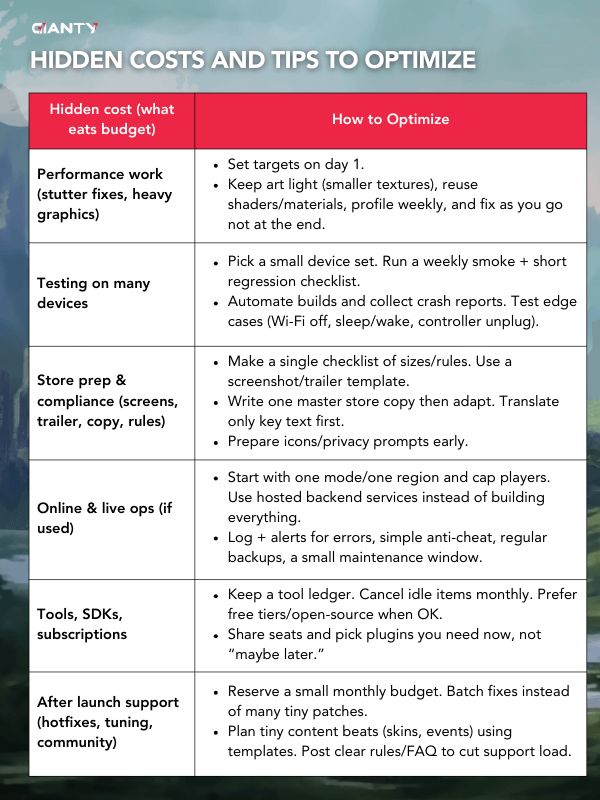
Lower Game Development Cost by Using AI
AI is a practical way to control Unity game development costs especially in the prototype phase. Tools that generate code, placeholder art, UI layouts and turning data can shorten the time from idea to prototype, reduce early manpower, and let the designer or development team focus on the game concept. This means more playtests sooner, clearer signals on what to build next, and spend where players actually feel the value.
GIANTY using AI through the entire game prototype pipeline from ideas and documentation to coding, art, and localization.
- Ideas & documentation: Brainstorm concepts, outline GDDs, write specs, summarize meetings using NotebookLM, GPT, Grok, Gemini
- Coding & implementation: Speed tasks with assisted coding by GitHub Copilot and Cursor handle autocomplete, refactors, and quick bug fixes
- Art & asset creation: AI- Generate placeholder or production-ready visuals to validate style early and iterate faster.
- Translation & localization: Auto-translate strings, check context, and push updates into build using ChatbotAI (Slack), Gemini API, Google Apps Script,…
Not only that, in the Kiooverse MVP, we used AI-generated music and sound to save budget while keeping a polished, engaging feel.
How much does a game MVP cost?
An MVP is a small, playable version of your game that proves the fun with minimal content. Think of it as “evidence before expansion.” Instead of guessing a full-game budget, you build a thin slice, test it, then invest more with confidence.
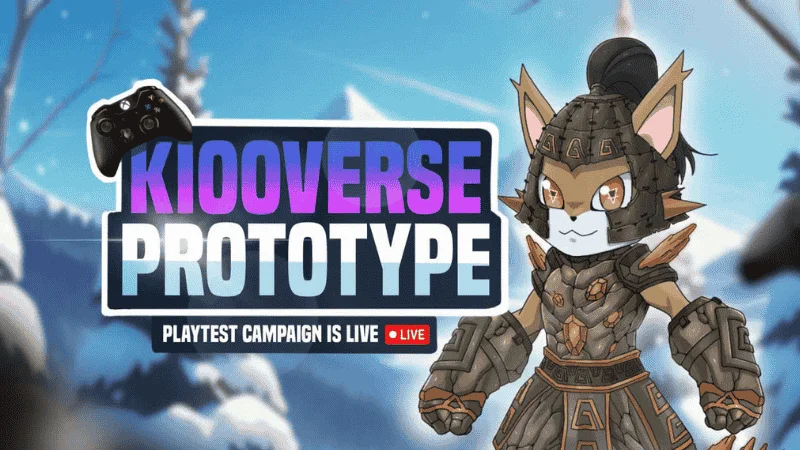
Prototype / Vertical Slice
Price range: $5,000 – $10,000
What you receive: A small, playable scene providing one core mechanic (solid controller+camera, basic enemy/interaction, placeholder or store assets, minimal UI, basic analytics, shareable build).
Use when: you need fast proof the idea is fun before expanding scope or hiring more roles; you’re preparing for an internal greenlight or early investor teaser; you want Unity game development cost estimation signals without overcommitting.
Lean MVP
Price range: $10,000 – $30,000
What you receive: A complete core loop with a few encounters/enemies, readable HUD/menus, simple progression (score/XP/unlocks), hybrid art, licensed audio, basic telemetry, weekly playable builds.
Use when: you want a player-testable MVP for Steam wishlists, soft playtests, publishers, or pitch decks.
Feature-Rich MVP
Price range: > $30,000
What you receive: Multiple encounters/levels, a boss fight, a light meta layer (abilities/upgrades), stronger custom art/animation and VFX telegraphs, store-readiness basics, deeper QA and perf budgets, docs and roadmap to full release.
Use when: you’re aiming for a soft-launchable MVP with measurable retention, creator outreach, or festival/Next Fest readiness; you want clearer signals for funding and a credible path to scale.
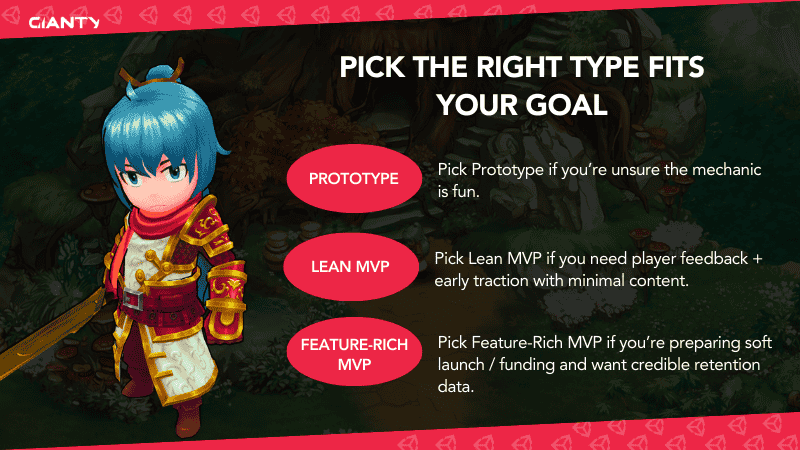
Want a detailed price for your MVP or Prototype? Contact us for a scoped quote – share your brief and we’ll map out clear ranges and a fast plan.
Unity Game Development Cost-saver: In-house team vs Outsourced Company
Should you hire freelancers, game outsourcing companies, or build an in-house team?
Your hiring choice changes both cost and risk. Here’s a plain comparison.
- For MVPs/vertical slice: a game outsourcing company often gives the best value (one team, one process, predictable sprints).
- For tiny tasks: freelance Unity developers are fine if you have a producer and extra QA.
- For multi-year plans: both outsourcing partners and an in-house team make sense once you have steady funding and a roadmap.
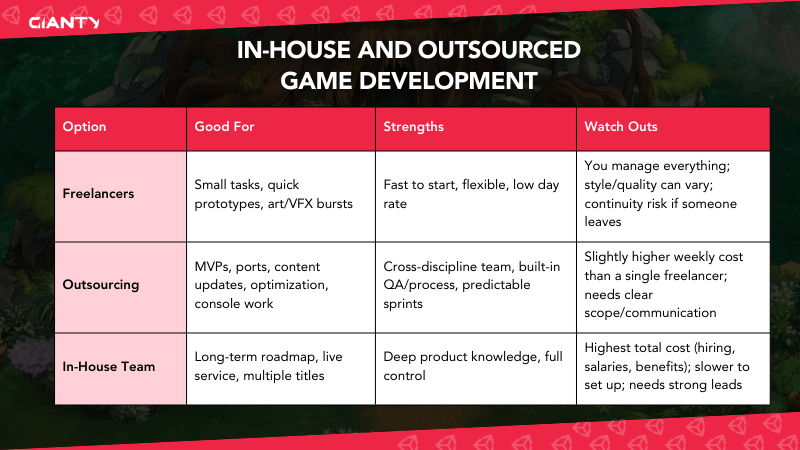
How to hire Unity game developers (simple checklist)
Unity Game Development Cost rises or falls based on who you hire, how clearly you brief them, and how you track progress. A short, clear process: one-paragraph brief, tiny paid test, and weekly playable builds keeps your game development cost lean and your team focused.
Use this simple checklist to hire Unity game developers with less risk, while keeping a tight game development cost estimation.
- Describe the game in one paragraph: What’s the core loop? Who is it for? What must be in the MVP?
- List your must-haves (3–5 items): Anything else is “nice to have.”
- Pick your platform and performance target: PC or mobile? 30 or 60 FPS? Any device limits?
- Share 3–5 visual references: These are example images/videos that show the style you want.
- Ask for shipped work or playable builds: Don’t just look at screenshots.
- Do a small paid test
- Track progress in a simple way: Weekly playable builds, a short status note, a list of known issues, and a quick plan for next week.
- Choose your engagement model:
- Time & Materials for ongoing MVP work
- Fixed Scope for a well-defined milestone
- Retainer for steady releases/content drops
Final Takeaway
The most reliable way to manage Unity game development cost is to sequence your investment: prove the core loop with a lean MVP, then scale content and platforms backed by player data. The teams that win are the ones that instrument early, optimize smartly, and spend where players feel it—on gameplay clarity, responsiveness, and a coherent visual identity.
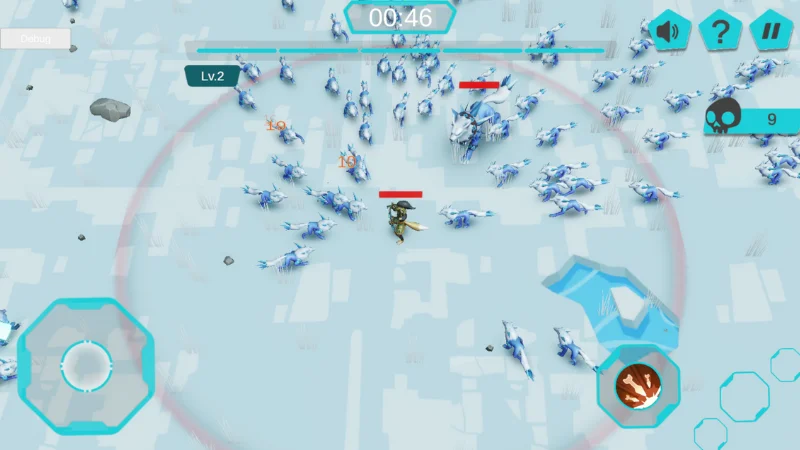
GIANTY can help you do exactly that: focused MVPs, clean code & pipelines, and art that looks great and runs fast – all without blowing up your budget. See our game development portfolio here.
FAQ
What’s a quick price range for a Unity MVP?
As planning ranges: Prototype/Vertical Slice $5,000–$10,000, Lean MVP $10,000–$30,000, Feature-Rich MVP > $30,000. Scope, art quality, online features, and platforms can move these up or down.
How long does an MVP take?
Prototype: about 2–6 weeks. Lean MVP: 6–12 weeks. Feature-Rich MVP: 12–16 weeks for one or two platforms.
How can I lower Unity game development cost without cutting quality?
Lock one clear MVP goal, go deep not wide, start with one platform, use store assets, add simple analytics, playtest weekly, and automate builds/tests.
Is outsourcing really a cost saver?
Usually, yes – when the partner brings mature pipelines, specialists on demand, and clear scopes. You reach a fun, testable build faster and avoid costly rework.
Does platform choice affect Unity game development cost?
Yes. Each extra platform adds UI/input work, performance tuning, store rules, and testing. Ship one platform first; port later with data.



